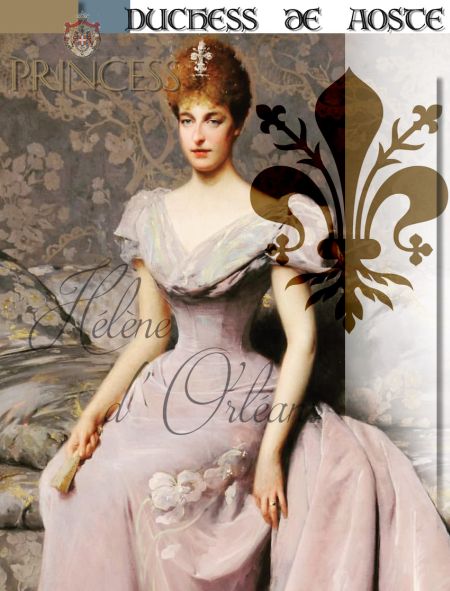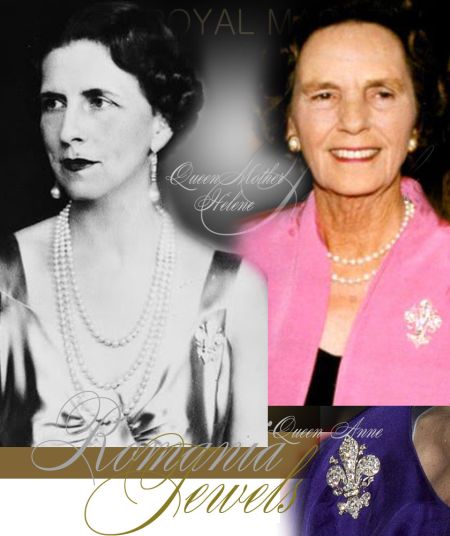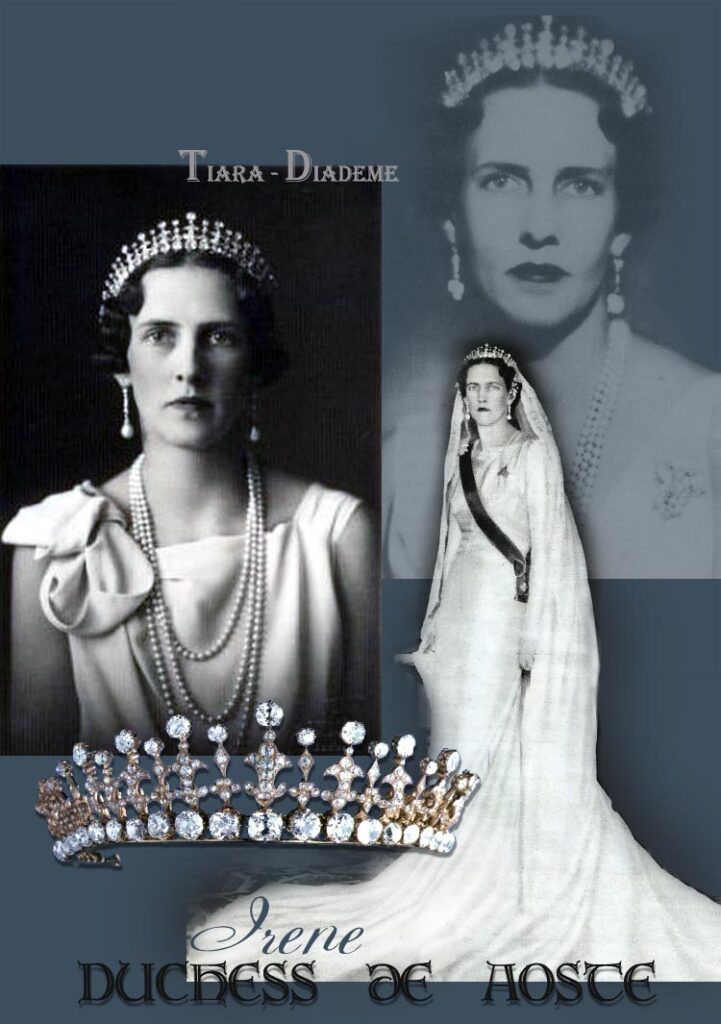Diamond Fleur-de-Lys Brooch
Princess Baby Bee Sachsen-Coburg-Gotha | Infanta Beatrice of Spain, Duchess of Galliera Brooch Heraldic Bourbon Lily -Could be worn as decorative hair ornament and Stomacher or Devante de Corsage

heraldische Lilie ist in der Heraldik eine gemeine Figur, bestehend aus drei stilisierten Blättern, die von einem Band zusammengehalten werden. Das mittlere Blatt ist oben und unten zugespitzt, die äußeren Blätter hängen herab und sind oben nach außen umgebogen Fleur-de-Lys oder Fleur-de-Lis Lilienblume, Lilienblüte, französische Lilie“ wild iris, the Iris pseudacorus, yellow flag in English, is yellow and grows in marshes (cf. the azure field, for water). Its name in German is Lieschblume (also gelbe Schwertlilie), but Liesch was also spelled Lies and Leys in the Middle Ages. It is easy to imagine that, in Northern France, the Lieschblume would have been called ‚fleur-de-lis‘. This would explain the name and the formal origin of the design, as a stylized yellow flag. There is a fanciful legend about Clovis which links the yellow flag explicitly with the French coat of arms,fleurs-de-lis or fleurs-de-lys
Florentine lily fleur-de-lis fleur-de-lis
Diamond Fleur-de-Lys Brooch
Princess Baby Bee Sachsen-Coburg-Gotha | Infanta Beatrice of Spain, Duchess of Galliera Brooch Heraldic Bourbon Lily -Could be worn as decorative hair ornament and Stomacher or Devante de Corsage

On June 9th, 1921, an extraordinary couple exchanged vows in a church in Copenhagen, creating a wedding that defied convention and captured the attention of the world. This was no ordinary union, and the circumstances surrounding it were far from ordinary. The bride, Her Royal Highness Princess Margrethe of Denmark, was the daughter of Prince Waldemar of Denmark, himself the youngest son of King Christian IX of Denmark, and Princess Marie of Orléans. The groom, His Royal Highness Prince René of Bourbon-Parma, hailed from a Catholic family, and their wedding took place in the Catholic Sacred Heart of Jesus church, despite the Protestant background of the Danish royal family.
Princess Margrethe’s upbringing was unique, as she was raised in the Catholic faith despite being a member of the Protestant Danish Royal Family. This was due to her mother’s French royal lineage. When Prince Waldemar and Princess Marie married in 1885, it was decided that their sons would be raised as Protestants, while their daughters would be raised as Catholics. Princess Margrethe happened to be the only daughter born from this Protestant-Catholic union.

Born in September 1895, Princess Margrethe received the names Margrethe Françoise Louise Marie. Her baptism took place in her parents‘ home two days after her birth, followed by a grander christening ceremony witnessed by family members and public representatives, befitting her status as the granddaughter of the King of Denmark.
Tragedy struck at a young age when Princess Margrethe’s mother passed away in 1909, leaving her motherless at the age of 10. Prince René’s background was equally noteworthy, with his father being the Duke of Parma and his mother born an Infanta of Portugal. He came from a large family, with half-siblings and siblings, including the famous last Empress of Austria, Zita. His brother Felix married the Grand Duchess of Luxembourg, and one of his half-sister Marie-Louise , married Prince Ferdinand I of Bulgaria.
The announcement of the royal engagement on March 11th came as a surprise to many, including those close to Prince Valdemar’s family. However, there were indications that some preparations had been made prior to the announcement. Prince René, accompanied by his brothers, had arrived the day before to meet with Princess Margrethe’s family. The engagement was celebrated at a birthday reception and luncheon for the Danish Crown Prince, where the rest of the family had the opportunity to meet the groom-to-be. Various private dinners were hosted by Prince Waldemar and the Queen Dowager, providing further opportunities for the families to bond and celebrate the upcoming union.
Pre-wedding events continued in the days leading up to the wedding, following the tradition of Royal weddings of that era. Guests arrived, and festivities commenced, including a grand dinner and ball hosted by Prince Waldemar at Bernsdorff Palace. The Royal guests, along with Princess Margrethe’s friends, enjoyed the enchanting evening adorned in elegant attire, captured in a photograph that immortalized the moment.
The photograph revealed a display of tiaras and jewelry, worn by the distinguished guests. Details regarding the specific events and their tiara usage were scarce due to the private nature of these occasions.
The wedding day arrived on June 9th, 1921, with preparations taking place at Bernsdorff Palace. The exterior was decorated with greenery, Danish flags, and the initials of the couple, creating a picturesque scene. Inside the church of the Sacred Heart of Jesus, invited guests, including representatives from official authorities, courtiers, and members of the Danish Catholic community, filled the pews. The church itself was adorned with a tasteful and impactful decoration scheme, featuring palms, ivy, rhododendrons, and hydrangeas.
Floral crosses representing both the Danish and French flags adorned the altar.
The Royal guests arrived at the church and were received by the Marshal of the Court, Chamberlain W. Rothe, and other dignitaries. The procession, led by the King and Queen, Prince René and his mother the Duchess of Parma, the Queen Dowager, and other Royal family members, made their way down the aisle to their designated seats. The anticipation grew as the moment approached for the bride and her father to make their entrance. Princess Margrethe, radiating joy, walked beside her father, her magnificent lace train held in place by a wreath of myrtle and orange flowers, accentuated by a delicate diamond tiara, a gift from the groom.
Following the church ceremony, the Royal family returned to Amalienborg, where a luncheon was hosted in their honor. The guests, who had received invitations, extended their congratulations to the newly weds and enjoyed a sumptuous meal accompanied by music and Danish and French melodies. The grandeur of the occasion was enhanced by the beautifully decorated tables adorned with pink roses and the sparkling crystal used for the dining experience.
Outside the palace, crowds of people had gathered, eagerly awaiting a glimpse of the newly weds. Princess Margrethe and Prince René made a balcony appearance, waving to the enthusiastic crowd, before returning inside to continue the luncheon. The celebrations concluded with the departure of the couple, bidding farewell to their family members, and embarking on their journey together. As they left, well-wishers showered them with rice and flowers, adding to the joyful atmosphere.
The wedding of Princess Margrethe and Prince René was a remarkable event that captured the imagination of the public. It defied expectations and highlighted the union of two individuals from different backgrounds and faiths. The day was filled with love, joy, and a sense of unity, as the Royal families and their guests came together to celebrate this extraordinary marriage.
more about the wedding gift and royal jewels of the bride:
On Thursday the festivities for the marriage of Princess Margarethe began with a grand court before their Majesties; This is followed by a ball on the 20th, a family dinner on the 22nd, a gala dinner on the 23rd and a gala dinner at the Empress Friedrich’s on the 24th. M. The civil marriage will take place in the palace of the Empress Friedrich, the church wedding in the castle chapel.
Numerous high guests are expected in Berlin. The Russian heir to the throne meets on 23 d. My; the voyage of the King of Denmark still seems uncertain, because of the blocking of the crossing by ice.
On the evening before the marriage of her youngest daughter, the Empress Friedrich had brought together the large number of family members who had rushed here for the special day to a gala family dinner.
The main table, at which the distinguished guests dined, was set in the large, magnificent dining room, which was filled with art treasures. The tapestry of the walls, which bear large golden flowers and arabesques on a golden silk background, are here and there covered with long hanging tapestries; the narrow wall opposite the entrance is separated from the adjoining room by a large red velvet drapery and decorated with costly silver shields, bowls and dividers. Right at the entrance is a work of art, a silver anniversary present, a clock of great value that serves as a resting point for a delightful group of marbles.
The table itself bore the gift which Queen Victoria of England had given to the Emperor and Empress Frederick in front of their Majesties‘ seatssilver wedding , three showpieces made of solid silver, serving as candelabra. The middle main piece depicts a hunting procession, a lady on horseback pulling out to hunt, with two dogs on a leash, which trot past a thick tree trunk, from whose branches the candlesticks rise. The side pieces are groups of trees with candelabra. Graduating in size, a number of other candlesticks, only in silver, lined up at the two ends of the table. In between there were display devices, fruit and flower bowls.
Threads of green leaves wound their way around the individual implements over the snow-white linen.
The whole was outshined by a mighty chandelier.
The bridal couple, Prince Friedrich Karl von Hessen in uniform, ate at the center of the table.Princess Margarethe in a delicate yellow silk robe richly trimmed with yellow feathers. To the right of the bride sat the reigning Empress, next to her Landgrave Alexander Friedrich von Hessen, to the left of the bridegroom the Empress Friedrich, dressed entirely in black silk, and next to her the King of Saxony in the blue uniform of the 10th Dragoons.
The Emperor’s seat was next to his sister, Princess Margarethe, opposite between the Grand Duchess of Baden and the groom’s mother, Landgravine Anna von Hessen, whose table neighbors were the Grand Duke of Baden and the Duke of Edinburgh. Since not all 60 guests had space at the table, a second table was set in the adjoining small dining room.


****



Learn more about the imperial wedding gifts Princess Helene of Orleans

This is not a Bourbon Lily – it’s different. It is the sign of Florence – the Giglio.
Irene Duchess de Aoste | Fleur de Lys diamond Brooch – Royal Diamond Tiara Jewels

Fleur de Lys of diamonds| Giglio Royal head Ornament from the Ladies of Florence to Hélène of Orléans, Duchess of Aoste |Princess of Orleans left to her daughter-in-law, Duchess Irene of Aoste, née Princess of Greece. She wore the diamond fleur de lys brooch often, as well she lent it to her sister, Princess Helene of Greece, later the Queen Mother of Romania.

After her death she left it to her sister, so it is worn by Queen Anna of Romania and now from Princess Margaretha of Romania.
Bulgaria Diamond Fringe Tiara | Bulgarian Wuerttemberg Royal Jewel History

Imperial Jewels of Bulgaria |Zarina Eleonore | Diamond Chaumet Crown Fringe Tiara
Königlicher Schmuck und Juwelen der Kaiserin Eleonore von Bulgarien

Imperial Jewels of Bulgaria | Royal Diamond Chaumet Crown| Princess Marie Louise of Bourbon-Parma Princess of Bulgaria Fringe Tiara
Spannende Geschichten zu historischem Schmuck, wie diese Brosche in Form einer Bourbonen Lilie>>
Princess Alexandra of Saxe-Coburg and Gotha (1878-1942) Princess of Hohenlohe-Langenburg.
The hereditary princess of Hohenlohe-Langenburg is pictured above, with a diamond fleur de Lys brooch.
She wore the brooch first after her engagement, which was a secret in May of the year and later for public in September 1895.
Her grandmother Queen Victoria was not amused.
Margarethe von Preussen – Prinzessin von Hessen | Hochzeit | Juwelen und Schmuck
Royal Wedding Presents to Princess Margaret of Prussia | Marriage Jewels | Castellani Gold Parure

